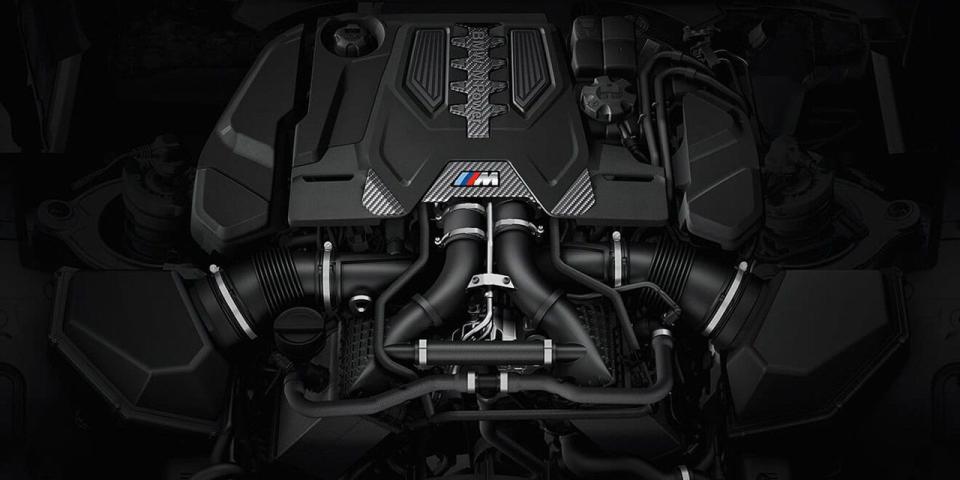Two BMW Twin-Turbo V-8s Emerge from the Same Factory, but Don’t Call Them the Same

From the August 2018 issue
In recent years, automakers have mastered the craft of extracting greater mileage from their engines, and we’re not just talking about mpg ratings. An increasingly popular powertrain strategy, widely practiced by German luxury brands and their in-house speed shops, reduces the number of engine configurations and displacements in a company’s portfolio while increasing the number of variations of those basic engines. The goal is to accommodate a range of applications, from sedans to crossovers to sports cars to factory hot rods, without starting from scratch. Think of 2.0-liter four-cylinders that stretch from 200 to 400 horsepower and V-8s that cover a similar spread in the 400-to-600-hp arena. This approach reins in the costs and complexity of both engine development and manufacturing.
In the age of computer-managed turbo engines, such power variations can be the result of tweaking boost levels and software, as in the Aston Martin DBS Superleggera. Or not. Consider BMW’s twin-turbo 4.4-liter V-8 in its least and most powerful forms: the 445-hp N63B44O1 in the 2018 X5 and the 617-hp S63B44T4 in the 2019 M5 Competition. BMW builds both in its Munich plant with the same bore and stroke, compression ratio, valve diameters, and cam profiles. But they are far from the same.
Building Blocks
The engines’ linerless aluminum-silicon-alloy blocks have the same cylinder dimensions but unique cooling and oiling passages. The M5 Competition engine also gets cross-bolted main-bearing caps for extra strength and rigidity.
An Extra Boost
Twin-scroll turbos improve the low-end response of both engines. In the X5, BMW designed the turbochargers with low-end torque and high efficiency in mind, whereas M engineers optimized the M5 Competition’s turbos for peak power: The compressor wheels are 0.2 inch larger in diameter than the X5’s and are designed to keep the air temperature low at the compressor outlets. The turbine wheels are shaped to minimize backpressure. A vacuum-actuated wastegate caps boost pressure at 11.5 psi in the X5. The M5 Competition limits boost to a peak of 25.9 psi using an electronically controlled wastegate that delivers quicker and more precise control.

Pressure to Perform
The X5’s 2900-psi fuel-injection pressure only sounds impressive if you don’t know that the M5 Competition sprays high-octane at more than 5000 psi. The higher pressure shortens injection duration, improves fuel atomization, and reduces cylinder-wall wetting. The M5’s fuel injectors and the fuel-pump piston and plunger have upgraded materials and coatings to cope with the elevated pressures.
In the Groove
Both X5 and M5 engines use aluminum pistons and forged-steel crankshafts and connecting rods, although the part designs are unique to each. The M5’s piston skirts feature an additional groove below the rings and eight drain holes in the oil scraper ring groove, rather than the four on the X5’s pistons. These mods reduce the likelihood of oil sneaking past the piston rings, particularly during high-rpm coasting. The M5’s engine uses 16 oil-spray nozzles-twice as many as the X5-to cool the pistons and lubricate the wrist pins.
Two-Pump Lump
The X5 engine circulates oil using a single pump at the rear of the engine, while the M5’s S63 adds a second oil pickup and pump at the front of the sump along with an electronically controlled valve that modulates the oil pressure. This ensures reliable oil delivery at up to 1.3 g’s of cornering, braking, or acceleration in the M5 Competition. The sports sedan also carries more oil-11.2 quarts versus 10.6-in part because it has an oil-to-air heat exchanger mounted horizontally in front of and below the radiator, whereas the X5 uses an oil-to-liquid cooler in the valley of the engine block.
M is for Mathlete
M eliminates the N63’s mass airflow meter, reducing pressure losses in the intake system by as much as 28 percent. Instead, the M5’s V-8 calculates air mass from ambient pressure and temperature, engine temperature and speed, throttle position, variable valve timing adjustments, and intake manifold pressure.
Our Kind of Crossover
Both engines use a hot-V design that directs exhaust gases toward the center of the block, but the executions differ. The X5 uses a configuration in which each manifold collects gases from the four cylinders in one bank. The M5 Competition uses a four-to-two crossover design, with each manifold directing exhaust from the outer cylinders on one bank and the inner two cylinders of the opposite bank to a turbo. This reduces exhaust-gas recirculation when the intake and exhaust valves are both open.
('You Might Also Like',)

 Yahoo Autos
Yahoo Autos 